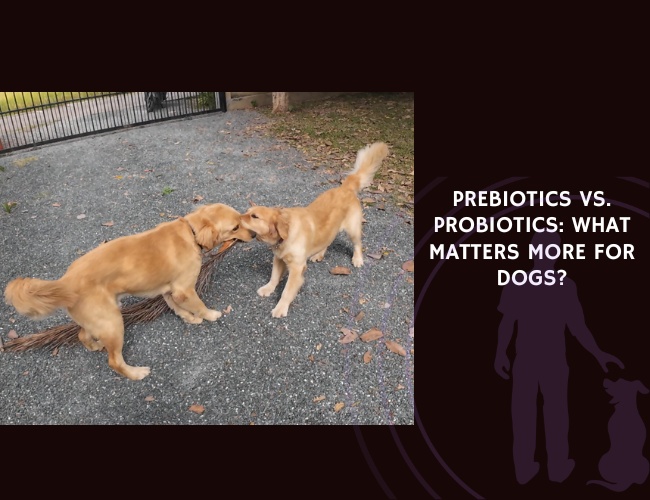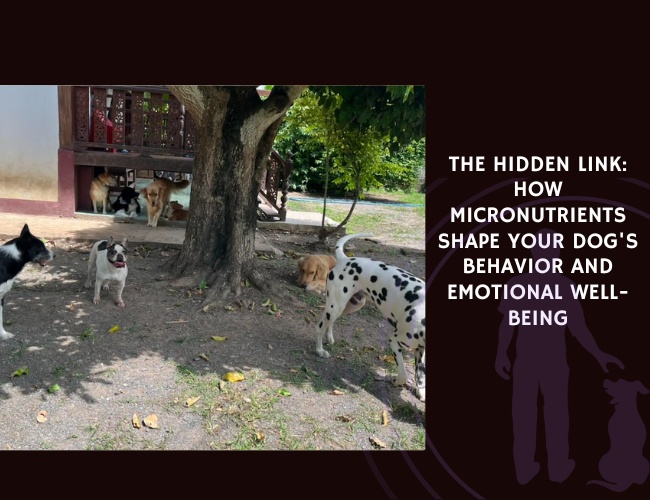Your dog’s gut health shapes everything from their digestion to their mood, and understanding the difference between prebiotics and probiotics can transform how you support their wellbeing. Let us guide you through this fascinating world of beneficial bacteria and the foods that nourish them, helping you make informed choices for your furry friend’s optimal health.
Biological Differences in Prebiotic and Probiotic Function
Understanding How Your Dog’s Gut Microbiome Works
Did you know your dog’s digestive system hosts trillions of microorganisms that influence everything from nutrient absorption to behavior? This complex ecosystem requires both beneficial bacteria (probiotics) and the specialized fibers that feed them (prebiotics).
Prebiotics: The Microbiome’s Nourishment
Think of prebiotics as fertilizer for your dog’s beneficial gut bacteria. These non-digestible food ingredients selectively stimulate the growth of helpful microbes already residing in your dog’s intestines. The most effective prebiotics for dogs include:
- Fructooligosaccharides (FOS): Found naturally in chicory root, these compounds specifically feed Bifidobacteria, supporting digestive health and immune function
- Mannanoligosaccharides (MOS): Derived from yeast cell walls, MOS binds harmful pathogens while encouraging beneficial bacteria growth
- Inulin: This longer-chain prebiotic provides sustained nourishment for gut bacteria, promoting steady microbial balance
Unlike probiotics, prebiotics don’t introduce new bacteria—they nurture what’s already there. This means they’re incredibly stable, surviving stomach acid and reaching the colon intact where they’re needed most.
Probiotics: Direct Microbial Reinforcement
Probiotics take a different approach by introducing live beneficial microorganisms directly into your dog’s digestive system. These microscopic allies must survive the harsh journey through stomach acid to colonize the gut effectively. The most researched canine probiotic strains include:
- Lactobacillus acidophilus: Supports lactose digestion and helps maintain healthy pH levels in the gut
- Bifidobacterium animalis: Particularly effective for dogs with sensitive stomachs and irregular bowel movements
- Enterococcus faecium: Shows promise in reducing diarrhea duration and improving stool quality
The challenge with probiotics lies in their viability—these living organisms require careful storage, proper dosing, and the right delivery method to reach your dog’s intestines alive and functional.
The Synergistic Relationship
Rather than competing approaches, prebiotics and probiotics work together in what scientists call “synbiotics.” Prebiotics create an environment where probiotics can thrive, while probiotics help break down prebiotics into beneficial compounds like short-chain fatty acids. This partnership means the question isn’t really “which is better?” but rather “how can we use both effectively?” 🐾
Influence on Digestion and Stool Quality
How Gut Support Translates to Daily Comfort
You might notice changes in your dog’s bathroom habits within days of starting prebiotic or probiotic supplementation—and these changes tell an important story about their internal health.
Stool Consistency and Digestive Regularity
Prebiotics work by gradually shifting the gut environment, typically showing results within 1-2 weeks:
- Increased water retention in the colon leads to softer, more regular stools
- Reduced gas production as beneficial bacteria outcompete gas-producing microbes
- Enhanced nutrient absorption, particularly of minerals like calcium and magnesium
Probiotics often work faster, sometimes improving stool quality within 24-48 hours:
- Direct competition with harmful bacteria reduces toxin production
- Improved intestinal barrier function decreases inflammation
- Enhanced enzyme production aids in breaking down proteins and fats
Supporting Dogs with Sensitive Stomachs
For dogs with inflammatory bowel disease (IBD) or chronic digestive issues, the prebiotic versus probiotic choice becomes more nuanced. Dogs with IBD often benefit from a “low and slow” approach with prebiotics, as their inflamed intestines may initially react to increased fermentation. Starting with small amounts of MOS-based prebiotics can gently encourage beneficial bacteria without overwhelming the system.
Conversely, dogs experiencing acute diarrhea or recovering from antibiotics may see faster relief from high-quality probiotics. The strain Enterococcus faecium SF68 has shown particular promise in reducing diarrhea duration by up to 30% in clinical studies.
Real-World Applications
Consider Max, a 7-year-old Golden Retriever with chronic loose stools. His veterinarian recommended starting with a prebiotic supplement containing 2g of FOS daily. Within two weeks, Max’s stools became firmer and less frequent. When a round of antibiotics for a skin infection disrupted his progress, adding a multi-strain probiotic helped restore balance within days. This combination approach—prebiotics for maintenance, probiotics for acute support—represents the practical wisdom many veterinarians now embrace. 🧡
Modulation of Immune Responses
Your Dog’s Gut as Their First Line of Defense
Nearly 70% of your dog’s immune system resides in their gut, making the microbiome a crucial player in overall health. Both prebiotics and probiotics influence this immune response, but through distinctly different mechanisms.
Mucosal Immunity and IgA Production
The intestinal lining produces immunoglobulin A (IgA), your dog’s primary defense against pathogens entering through the digestive system. Prebiotics enhance this process by:
- Increasing the production of short-chain fatty acids, particularly butyrate, which strengthens the intestinal barrier
- Supporting the growth of bacteria that stimulate IgA-producing cells
- Creating an acidic environment that naturally inhibits pathogen growth
Studies show dogs supplemented with FOS-based prebiotics demonstrate up to 25% higher fecal IgA levels after 6 weeks of supplementation.
Probiotics and Direct Immune Modulation
While prebiotics work indirectly, probiotics interact directly with immune cells in the gut:
- Lactobacillus strains communicate with dendritic cells, helping regulate inflammatory responses
- Bifidobacterium species produce compounds that enhance natural killer cell activity
- Certain probiotic strains can reduce the severity of allergic reactions by promoting regulatory T-cell development
Managing Allergies and Chronic Inflammation
For dogs with environmental allergies or food sensitivities, the prebiotic-probiotic decision often depends on the underlying trigger. Dogs with severe allergies may initially respond better to targeted probiotic therapy, as specific strains like Lactobacillus rhamnosus can help modulate overactive immune responses.
However, long-term management often requires prebiotic support to maintain a diverse, stable microbiome. The combination of MOS and FOS prebiotics has shown particular promise in reducing skin inflammation scores in atopic dogs by supporting anti-inflammatory bacterial populations.
This immune connection explains why many dogs with improved gut health show unexpected benefits—shinier coats, reduced ear infections, and better wound healing all stem from a well-balanced microbiome supporting systemic immunity. 🐾
Behavioral and Cognitive Changes
The Gut-Brain Connection in Your Canine Companion
The discovery that gut bacteria influence behavior has revolutionized how we understand canine wellness. Your dog’s microbiome produces neurotransmitters, influences stress hormones, and communicates directly with the brain through the vagus nerve.
Serotonin Production and Mood Regulation
Did you know that up to 90% of your dog’s serotonin—the “happiness hormone”—is produced in their gut? Prebiotics support this process by:
- Feeding bacteria that produce tryptophan, serotonin’s precursor
- Maintaining stable blood sugar levels, reducing mood swings
- Supporting consistent energy throughout the day
Dogs supplemented with inulin-based prebiotics often show improved stress resilience during thunderstorms, vet visits, or separation—though these changes typically take 4-6 weeks to manifest.
Probiotics and Acute Stress Response
Probiotics can more directly influence behavior through several pathways:
- Lactobacillus helveticus produces GABA, a calming neurotransmitter
- Bifidobacterium longum reduces cortisol levels during stressful events
- Multi-strain probiotics improve cognitive function in senior dogs
Research with shelter dogs—who experience extreme stress—shows that probiotic supplementation can reduce anxious behaviors like excessive barking and pacing within just two weeks.
Microbiota Diversity and Behavioral Traits
The relationship between gut diversity and behavior is particularly fascinating. Dogs with more diverse microbiomes typically display:
- Greater adaptability to new situations
- Reduced reactivity to strangers
- Better learning retention in training scenarios
This suggests that combining prebiotics (which increase diversity over time) with probiotics (which can quickly introduce beneficial species) might offer the most comprehensive behavioral support.
Consider Bailey, a rescued Beagle with severe separation anxiety. Her treatment protocol included both a diverse prebiotic blend and a specific probiotic strain (Bifidobacterium longum BL999) known for its anti-anxiety effects. After 8 weeks, Bailey could remain calm alone for up to 2 hours—a transformation her adopter called “miraculous.” This illustrates how gut health interventions can complement traditional behavioral training. 🧡
Feed. Balance. Thrive.
Your dog’s health begins in the gut.
Every wag, every bark, every bowel movement reflects an invisible world of bacteria and fiber. When you nourish that system with the right support, the rest of your dog’s wellbeing begins to align.
It’s not a choice—it’s a partnership.
Prebiotics feed what’s already working. Probiotics reinforce what’s missing. Together, they build a resilient system capable of resisting stress, absorbing nutrients, and calming inflammation from the inside out.



You hold the power to transform their life.
By understanding what your dog’s gut truly needs, you’re not just giving supplements—you’re rewriting their health story. One scoop, one strain, one smart choice at a time.
Beneficial Dog Populations and Optimal Delivery Methods
Tailoring Gut Support to Your Dog’s Life Stage
Not all dogs benefit equally from prebiotics and probiotics. Understanding your dog’s specific needs helps you choose the most effective approach.
Puppies: Building a Foundation
Puppies are born with sterile guts and acquire their microbiome from their mother and environment. During this critical window:
- Prebiotics help establish diverse bacterial populations, with MOS being particularly beneficial for immune development
- Probiotics can prevent infectious diarrhea, with Enterococcus faecium showing a 40% reduction in puppy diarrhea incidence
- The combination approach works best, mimicking the natural prebiotics in mother’s milk while adding beneficial bacteria
Start with 0.5g of prebiotic per 10 pounds of body weight, increasing gradually as the puppy grows.
Senior Dogs: Maintaining Balance
Aging dogs experience natural microbiome shifts that can impact health:
- Decreased bacterial diversity contributes to cognitive decline
- Reduced digestive efficiency affects nutrient absorption
- Weakened immune responses increase infection susceptibility
For senior dogs, prebiotics offer gentle, sustained support without overwhelming sensitive systems. FOS and inulin combinations at 2-3g daily help maintain diversity. Adding probiotics during stressful events (boarding, medical procedures) provides extra protection.
Rescue Dogs: Healing Through Gut Health
Rescued dogs often arrive with compromised microbiomes due to:
- Poor nutrition in their past
- Chronic stress altering gut bacteria
- Multiple antibiotic treatments for infections
These dogs benefit from a “restoration protocol”:
- Week 1-2: Gentle prebiotic introduction (start with 0.5g MOS)
- Week 3-4: Add multi-strain probiotics (minimum 1 billion CFU)
- Week 5+: Gradually increase both to therapeutic levels
Post-Antibiotic Recovery
Antibiotics save lives but devastate gut bacteria indiscriminately. Recovery requires strategic intervention:
- During antibiotics: Give probiotics 2-3 hours apart from medication
- Post-treatment: Continue probiotics for 2-4 weeks
- Long-term: Prebiotics rebuild diversity over 6-8 weeks
Optimal Delivery Methods and Dosing
The effectiveness of any supplement depends on proper delivery:
Prebiotic Delivery:
- Powdered forms mix easily into food
- Start with 1/4 recommended dose, increasing over 2 weeks
- Morning feeding allows all-day fermentation
- Store in cool, dry places—prebiotics are stable
Probiotic Delivery:
- Enteric-coated capsules survive stomach acid best
- Powders need protective carriers (like maltodextrin)
- Give with meals to buffer stomach acid
- Refrigeration extends viability
- Check expiration dates—potency decreases over time
Dosage Guidelines:
- Small dogs (under 25 lbs): 1-2g prebiotics, 1-5 billion CFU probiotics
- Medium dogs (25-60 lbs): 2-4g prebiotics, 5-10 billion CFU probiotics
- Large dogs (over 60 lbs): 4-6g prebiotics, 10-20 billion CFU probiotics
Remember, more isn’t always better—excessive prebiotics cause gas and discomfort, while probiotic overdoses typically just waste money as excess bacteria pass through. 🐾
Making the Right Choice for Your Dog
A Personalized Approach to Gut Health
After exploring the science, you might wonder: should I choose prebiotics or probiotics for my dog? The answer lies in understanding your dog’s individual needs and health goals.
When Prebiotics Take Priority:
- Maintaining long-term digestive health
- Supporting gradual behavior improvements
- Building immune resilience
- Managing weight through improved metabolism
- Preventing age-related microbiome decline
When Probiotics Lead the Way:
- Acute digestive upset or diarrhea
- Post-antibiotic recovery
- Immediate stress support
- Managing active allergies
- Supporting specific health conditions with targeted strains
The Power of Combination: Synbiotics
Increasingly, veterinary nutritionists recommend synbiotic approaches—combining prebiotics and probiotics for comprehensive support. This strategy:
- Ensures introduced probiotics have food to thrive
- Creates lasting microbiome changes
- Provides both immediate and long-term benefits
- Addresses multiple health aspects simultaneously
Practical Implementation
Start your dog’s gut health journey with these steps:
- Assess your dog’s current health: Note digestive patterns, energy levels, and any behavioral concerns
- Choose quality products: Look for prebiotics with defined FOS/MOS content and probiotics with guaranteed CFU counts
- Introduce gradually: Begin with prebiotics to prepare the gut environment
- Monitor changes: Keep a simple diary of stool quality, behavior, and overall wellbeing
- Adjust as needed: Every dog responds differently—be patient and observant
Working with Your Veterinarian
While supplements are generally safe, certain conditions warrant professional guidance:
- Immunocompromised dogs need carefully selected probiotics
- Dogs with severe IBD may require specialized prebiotic types
- Unexpected reactions should prompt veterinary consultation
Your veterinarian can recommend specific products and help monitor your dog’s progress through regular check-ups and potentially fecal microbiome testing.
Conclusion: It’s Not Either-Or, It’s Both-And
The question “what matters more for dogs—prebiotics or probiotics?” misses the beautiful complexity of the canine microbiome. Like asking whether water or sunlight matters more for a garden, both elements play crucial, complementary roles in your dog’s health.
Prebiotics offer sustainable, long-term support by nourishing your dog’s existing beneficial bacteria. They’re stable, cost-effective, and create lasting positive changes in the gut environment. Probiotics provide targeted, rapid intervention when your dog needs immediate support, introducing specific beneficial bacteria to address acute challenges.
The optimal approach for most dogs involves strategic use of both:
- Daily prebiotic supplementation for maintenance
- Probiotic additions during times of stress or illness
- Synbiotic combinations for comprehensive health support
As you embark on supporting your dog’s gut health, remember that every dog is unique. What transforms one dog’s health might need adjustment for another. Stay observant, work with your veterinary team, and celebrate the small improvements along the way.
Your commitment to understanding and supporting your dog’s microbiome represents the cutting edge of canine wellness. By nourishing the trillions of tiny allies in your dog’s gut, you’re not just improving their digestion—you’re enhancing their immunity, supporting their mental wellbeing, and potentially adding years of vibrant life to your time together. 🧡
Next time you see your dog’s relaxed tail wag after a satisfying meal or notice their calm demeanor during a typically stressful situation, you’ll know their well-supported microbiome is working its magic from the inside out.










